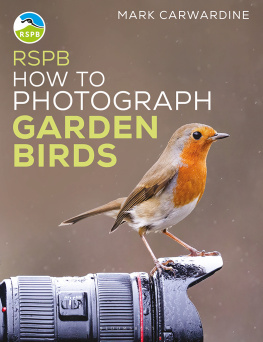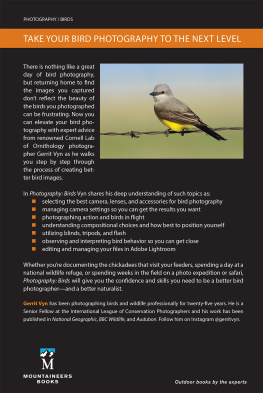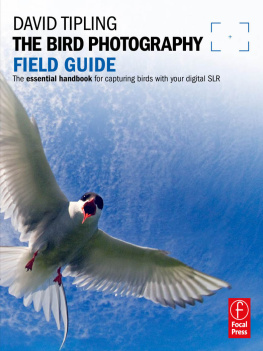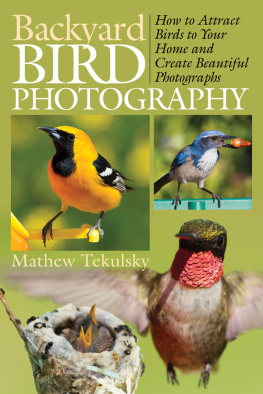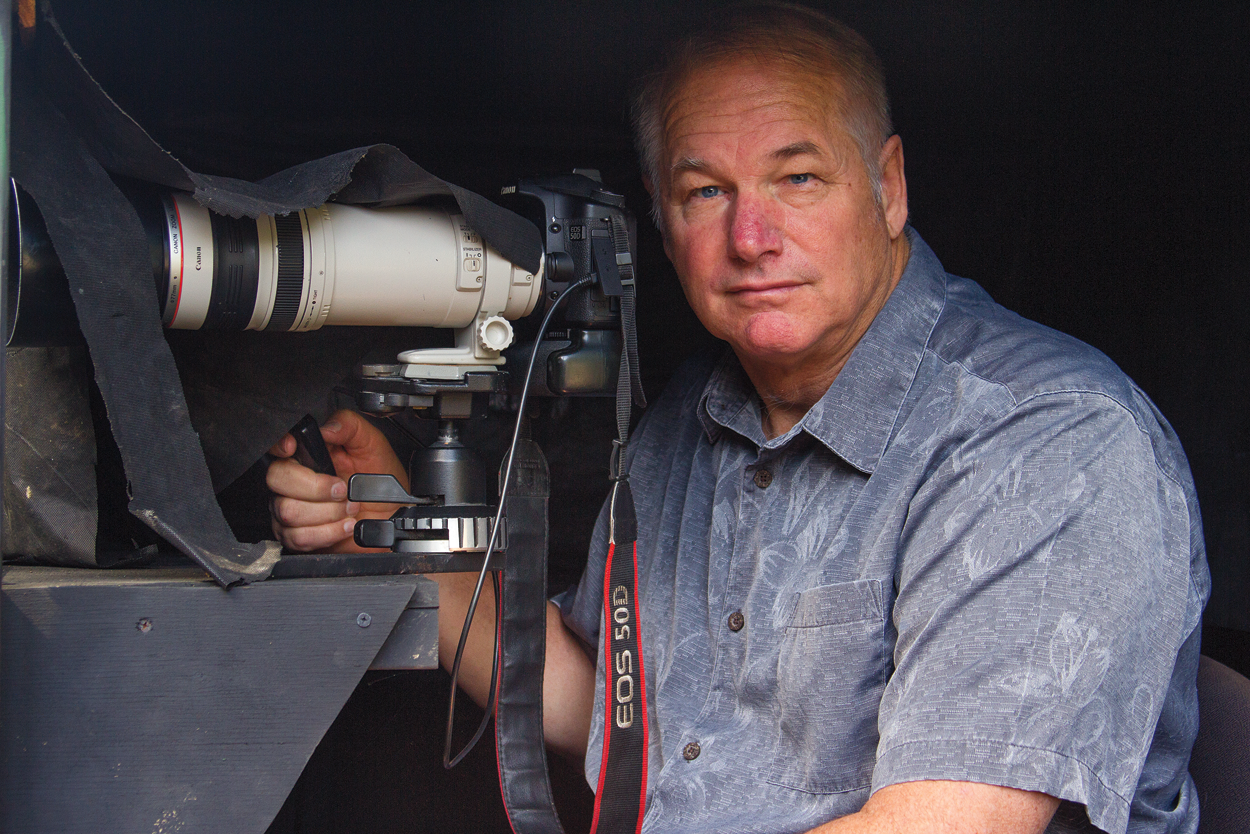J. Chris Hansen is a wildlife and nature photographer who lives and works in the redwoods of Northern California. His images have been published in numerous outdoor magazines, including Mule Deer and California Hunter. He has a passion for bird photography and can often be found photographing in his backyard.
http://christhephotog.blogspot.com/
Secrets of Backyard Bird Photography
J. Chris Hansen

J. Chris Hansen (christhephotog.blogspot.com)
Project Editor: Maggie Yates
Copyeditor: Maggie Yates
Layout: Hespenheide Design
Cover Design: Helmut Kraus, www.exclam.de
Printer: Friesens Corporation, Altona, Canada
Printed in Canada
ISBN 978-1-937538-55-2
1st Edition 2014
2014 by J. Chris Hansen
Rocky Nook Inc.
802 East Cota St., 3rd Floor
Santa Barbara, CA 93103
www.rockynook.com
Library of Congress Cataloging-in-Publication Data
Hansen, J. Chris, author.
Secrets of backyard bird photography / by J. Chris Hansen. -- 1st edition.
pages cm
ISBN 978-1-937538-55-2 (hardbound : alk. paper)
1. Photography of birds. 2. Photography--Digital techniques. 3. Single-lens reflex cameras. I. Title.
TR729.B5H36 2014
778.9328--dc23
2014008573
Distributed by OReilly Media
1005 Gravenstein Highway North
Sebastopol, CA 95472
All rights reserved. No part of the material protected by this copyright notice may be reproduced or utilized in any form, electronic or mechanical, including photocopying, recording, or by any information storage and retrieval system, without written permission of the publisher.
Many of the designations in this book used by manufacturers and sellers to distinguish their products are claimed as trademarks of their respective companies. Where those designations appear in this book, and Rocky Nook was aware of a trademark claim, the designations have been printed in caps or initial caps. All product names and services identified throughout this book are used in editorial fashion only and for the benefit of such companies with no intention of infringement of the trademark. They are not intended to convey endorsement or other affiliation with this book.
While reasonable care has been exercised in the preparation of this book, the publisher and author assume no responsibility for errors or omissions, or for damages resulting from the use of the information contained herein or from the use of the discs or programs that may accompany it.
This book is printed on acid-free paper.
This book is dedicated to God, who makes all things possible,
and to my family, Lenore, Jay, and Annika, for their loving support of the writing of this book.
Acknowledgements
To Steve Hellman, for helping bring this book to life with his editing expertise and encouragement.
To my parents, John and Betty Hansen, for raising me with a love for the outdoors and all of Gods creation.
For the team at Rocky Nook, Joan Dixon, Maggie Yates, Alison Smith, and Matthias Rossmanith, for their professionalism and invaluable help in making this book a reality.
Varied thrush on rocks set in a backyard pond
Introduction
This comprehensive guide offers a variety of techniques and projects for backyard bird photography. You will learn how to use feeders, perches, backgrounds, blinds, and the proper camera equipment to create professional-quality images. In its simplest form, photographing birds in your backyard is convenient, economical, and very rewarding; ultimately, it can become an addictive adventure.
Any type of backyard, from the wide-open space of a western ranch to a city apartment with a patio or deck, can yield excellent images of local birds. By providing perches, feeders, and water sources, and by utilizing blinds, the photographer can create an inviting environment for birds. With the help of the information in this book and some practice, you will have the tools to begin creating fantastic bird images.
The advantages of backyard bird photography are many. The primary advantage is the fact that travel is unnecessary. No flights, car rentals, or hotel rooms; no big expenses paying for meals or gas; no fighting traffic to go anywhere. When your primary location for shooting is your backyard, you dont even have to shave or put on your makeup. The birds wont care if youve shaved or not.
The second advantage of shooting in your yard is that your bird subjects are often easier to find and capture than wild birds. Because neighborhood birds are accustomed to sharing their space with people, they dont typically see us as a threatunless you get too close. While you have to travel to the habitats of wild birds to photograph them, backyard birds are easy to find because they come to you. Your backyard is their habitat! This book offers ideas for ways to draw the birds into your camera range.
Shooting bird images in your own backyard is also a huge time saver. The time you would have spent traveling can now be spent in the comfort of your own location shooting images at your convenience. You wont risk spending hundreds or thousands of dollars on travel to a place where you could get rained out.
There are disadvantages to backyard bird photography, as well. The biggest problem is that you are limited to the species of birds that you can attract to your backyard. If you are shooting from your apartment in the Bronx, it is unlikely that youll have the opportunity to photograph penguins. Another consideration is the limits of migration: youll only be able to photograph some species of birds during certain times of year.
Another disadvantage to shooting only in your backyard is that it can be easy to fall into a rut. Its up to you to provide the spark to keep your bird photography fresh. One of the most creative aspects of backyard birding is setting up the backyard habitat. You have the opportunity to design and produce beautiful set-ups and backgrounds for your images.
Goldfinch on blossom next to a tube feeder
CHAPTER 1 The Best Camera and Equipment
I have found that the best camera to use is a Digital Single Lens Reflex (DSLR), with a pixel count of six megapixels or larger. These cameras have interchangeable lenses that can be purchased in varying powers of up to 800 mm. Any of the major manufactured cameras, such as Canon, Nikon, Pentax, Sigma, Olympus, Panasonic, Sony, and Fuji, will work quite well for this purpose.
As far as lenses are concerned, it is best to use a telephoto lens with a focal length of at least 200 mm or longer. The longer the zoom of your lenses, the better they are for bird photography, but the more expensive they will be. My personal favorite is a 100-400 mm telephoto zoom lens. A zoom lens allows you to move in closer or pull further away from your subject, so you dont have to change positions the way you would with a prime lens. This is advantageous when a variety of birds of different sizes visit your bird feeder set-ups, and you need a tighter (or wider) shot.



